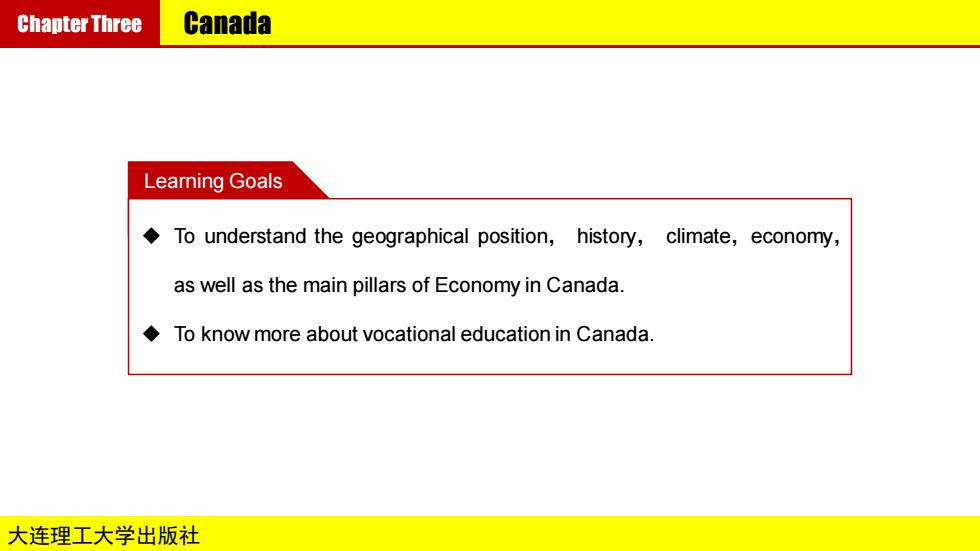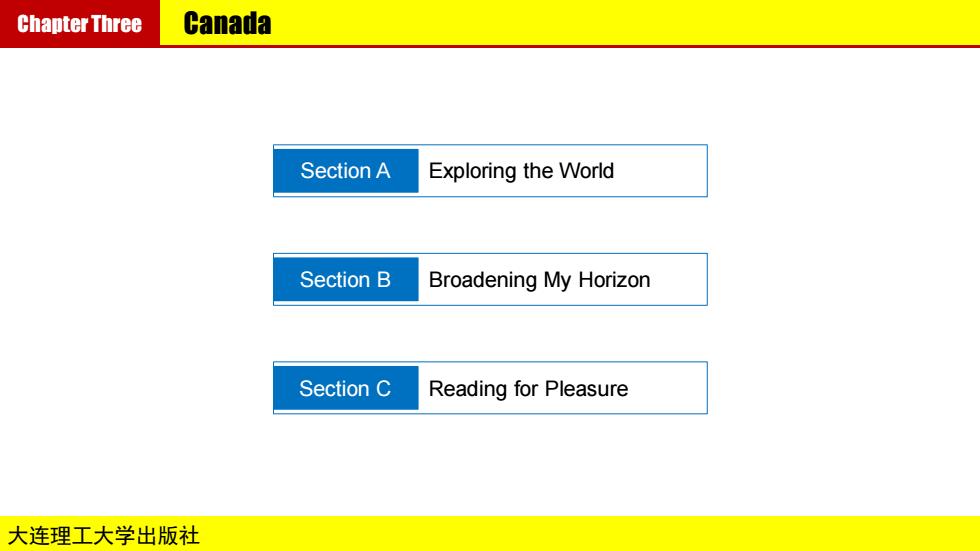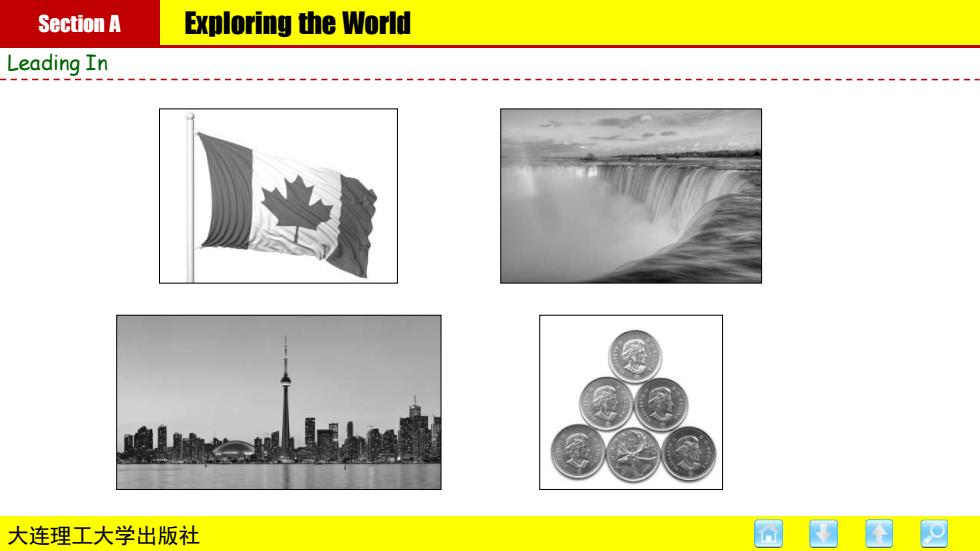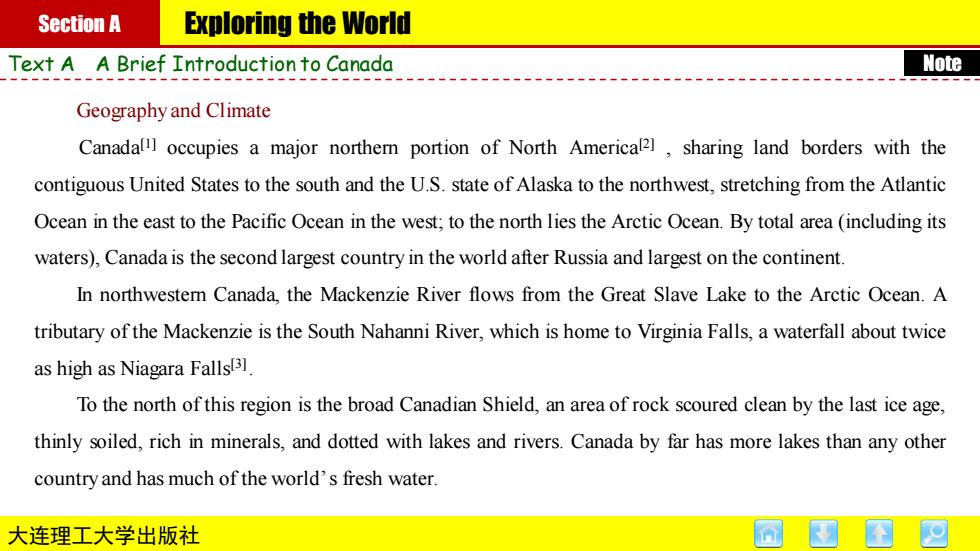
Chapter Three Canada Learning Goals To understand the geographical position,history,climate,economy, as well as the main pillars of Economy in Canada. To know more about vocational education in Canada. 大连理工大学出版社
大连理工大学出版社 Chapter Three Canada Learning Goals ◆ To understand the geographical position, history, climate,economy, as well as the main pillars of Economy in Canada. ◆ To know more about vocational education in Canada

Chapter Three Canada Section A Exploring the World Section B Broadening My Horizon Section C Reading for Pleasure 大连理工大学出版社
大连理工大学出版社 Chapter Three Canada Section A Exploring the World Section B Broadening My Horizon Section C Reading for Pleasure

Section A Exploring the World Leading In 大连理工大学出版社 圈团①四
大连理工大学出版社 Section A Exploring the World Leading In

Section A Exploring the World Text AA Brief Introduction to Canada Note Geography and Climate Canadalll occupies a major northem portion of North Americal21,sharing land borders with the contiguous United States to the south and the U.S.state of Alaska to the northwest,stretching from the Atlantic Ocean in the east to the Pacific Ocean in the west;to the north lies the Arctic Ocean.By total area(including its waters),Canada is the second largest country in the world after Russia and largest on the continent. In northwestemn Canada,the Mackenzie River flows from the Great Slave Lake to the Arctic Ocean.A tributary of the Mackenzie is the South Nahanni River,which is home to Virginia Falls,a waterfall about twice as high as Niagara Falls31. To the north of this region is the broad Canadian Shield,an area of rock scoured clean by the last ice age, thinly soiled,rich in minerals,and dotted with lakes and rivers.Canada by far has more lakes than any other country and has much of the world's fresh water. 大连理工大学出版社
大连理工大学出版社 Section A Exploring the World Text A A Brief Introduction to Canada Geography and Climate Canada[1] occupies a major northern portion of North America[2] , sharing land borders with the contiguous United States to the south and the U.S. state of Alaska to the northwest, stretching from the Atlantic Ocean in the east to the Pacific Ocean in the west; to the north lies the Arctic Ocean. By total area (including its waters), Canada is the second largest country in the world after Russia and largest on the continent. In northwestern Canada, the Mackenzie River flows from the Great Slave Lake to the Arctic Ocean. A tributary of the Mackenzie is the South Nahanni River, which is home to Virginia Falls, a waterfall about twice as high as Niagara Falls[3] . To the north of this region is the broad Canadian Shield, an area of rock scoured clean by the last ice age, thinly soiled, rich in minerals, and dotted with lakes and rivers. Canada by far has more lakes than any other country and has much of the world’s fresh water. Note

Section A Exploring the World Text AA Brief Introduction to Canada Political System A federation comprising ten provinces and three territories,Canada is a parliamentary democracy and a constitutional monarchy,with Queen Elizabeth II as its head of state.It is a bilingual and multicultural country, with both English and French as official languages both at the federal level and in the province of New Brunswick. Technologically advanced and industrialized,Canada maintains a diversified economy that is heavily reliant upon its abundant natural resources and upon trade-particularly with the United States,with which Canada has had a long and complex relationship. The provinces are responsible for most of Canada's social programs(such as health care,education,and welfare)and together collect more revenue than the federal government,an almost unique structure among federations in the world.Using its spending powers,the federal government can initiate national policies in provincial areas,such as the Canada Health Act,the provinces can opt out of these,but rarely do so in practice. Equalization payments are made by the federal government to ensure that reasonably uniform standards of services and taxation are kept between the richer and poorer provinces. 大连理工大学出版社
大连理工大学出版社 Section A Exploring the World Text A A Brief Introduction to Canada Political System A federation comprising ten provinces and three territories, Canada is a parliamentary democracy and a constitutional monarchy, with Queen Elizabeth II as its head of state. It is a bilingual and multicultural country, with both English and French as official languages both at the federal level and in the province of New Brunswick. Technologically advanced and industrialized, Canada maintains a diversified economy that is heavily reliant upon its abundant natural resources and upon trade — particularly with the United States, with which Canada has had a long and complex relationship. The provinces are responsible for most of Canada’s social programs (such as health care, education, and welfare) and together collect more revenue than the federal government, an almost unique structure among federations in the world. Using its spending powers, the federal government can initiate national policies in provincial areas, such as the Canada Health Act; the provinces can opt out of these, but rarely do so in practice. Equalization payments are made by the federal government to ensure that reasonably uniform standards of services and taxation are kept between the richer and poorer provinces